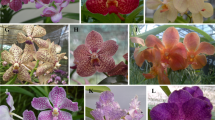Summary
The effect ofin planta treatments with auxin inhibitors such as 2,3,5 triiodobenzoic acid (TIBA) on regeneration of plantsin vitro is not known. Here, we show the beneficial effect of preconditioning sugarbeet plants in the greenhouse with TIBA (3 mg/1) for efficientin vitro plant regeneration via a callus phase from cultured leaf explants. Without this treatment, no shoot developed on the control leaf-calluses. Several hundred plants were routinely regenerated using this protocol. More importantly, the number of shoots per explantcallus increased drastically over the subsequent subculture period. The most favorable media for callus induction contained a combination of an auxin and a cytokinin (0.1 mg/1 2,4-dichlorophenoxyacetic acid and 1 mg/1 N-6 benzylaminopurine) or a cytokinin alone (2.2 mg/1 thidiazuron). However, only the callus derived from leaves of TIBA-treated genotypes and induced on thidiazuron-medium produced numerous shoots. Histological studies showed the formation of meristematic zones only in the organogenic callus developed on thidiazuron-coutaining medium. The analysis of peroxidase activity showed that the activity was higher for the TIBA-treated plants than for the untreated control plants.
Similar content being viewed by others
Abbreviations
- BAP:
-
N-6 benzylaminopurine
- 2,4-D:
-
2,4-dicliloropbenoxyacetic acid
- IAA:
-
indoleacetic acid
- IBA:
-
indole-3-butyric acid
- MOPS:
-
N-morpbolino-3 propanesulfonic acid
- NAA:
-
1-naphtbaleneacetic acid
- OD:
-
optical density
- TIBA:
-
2,3,5-triiodobenzoic acid
- TDZ:
-
thidiazuron
References
Bradford MM (1976) Biochem 72: 248–254
Bretagne B, Chupeau M-C, Chupeau Y, Fouilloux G (1994) Plant Cell Reports 14: 120–124
Capelle SC, Mok DWS, Kirchner SC, Mok Me (1983) Plant Physiol 73: 796–802
Catlin DW (1990) Plant Cell Reports 9: 285–288
De Greef W, Jacobs M (1979) Plant Science Letters 17: 55–61
Depta H, Rubery PH (1984) J Plant Physiol 115: 371–387
Detrez C, Tétu T, Sangwan RS, Sangwan-Norreel BS (1988) J Exp Bot 39:917–926
Doley WP, Saunders JW (1989) Plant Cell Reports 8: 222–225
Gaspar T, Penel C, Hagege D, Greppin H (1991) In: J Lobarzewski, H Greppin, C Penel and T Gaspar (eds) Biochenucal, Molecular and Physiological Aspects of Plant Peroxidases, pp 249–280
George MW, Tripepi RR (1994) Plant Cell Tissue Organ Cult 39: 27–36
Hooker MP, Nabors MW (1977) Z Pflanzenphysiol 84: 237–246
Jacq B, Tétu T, Sangwan RS, De Laat A, Sangwan-Norreel BS (1992) Plant Cell Reports 11: 329–333
Jacq B, Tétu T, Sangwan RS, De Laat A, Sangwan-Norreel BS (1993) Plant Breeding 110: 185–191
Kaminek M, Armstrong DJ (1990) Plant Physiol 93: 1530–1538
Kevers CL, Coumans M, De Greef W, Jacobs M, Gaspar T (1981) Z Pflanzenphysiol 101: 79–87
Krens FA, Jamar D (1989) J Plant Physiol 134: 651–655
Malik K A, Saxena PK (1992) Planta 186: 384–389
Murashige T, Skoog F (1962) Physiol Plant 15: 473–497
Nielsen JM, Hansen J, Brandt K (1995) Plant Cell Tissue Organ Cult 41: 165–170
Owens LD, Eberts DR (1992) Plant Cell Tissue Organ Cult 31: 195–201
Özcan S, Barghchi M, Firek S, Draper J (1993) Plant Cell Tissue Organ Cult 34: 271–277
Ricthie GA, Short KC, Davey MR (1989) J Exp Bot 40: 277–283
Rubery PH, Sheldrake AR (1974) Planta 118: 101–121
Sangwan RS, Bourgeois Y, Brown S, Vasseur G, Sangwan-Norreel BS (1992) Planta 188: 439–456
Saunders JW, Shin K (1986) Crop Sci 26: 1240–1244
Saunders JW, Doley WP (1986) J Plant Physiol 124: 473–479
Tétu T, Sangwan RS, Sangwan-Norreel (1987) J Exp Bot 38: 506–517
Van Geyt JPC, Jacobs M (1985) Plant Cell Reports 4: 66–69
Author information
Authors and Affiliations
Additional information
Communicated by H. Lörz
Rights and permissions
About this article
Cite this article
Roussy, I., Dubois, F., Sangwan, R.S. et al. In planta 2,3,5 truodobenzoic acid treatment promotes high frequency and routine in vitro regeneration of sugarbeet (Beta vulgaris L.) plants. Plant Cell Reports 16, 142–146 (1996). https://doi.org/10.1007/BF01890855
Received:
Revised:
Issue Date:
DOI: https://doi.org/10.1007/BF01890855




